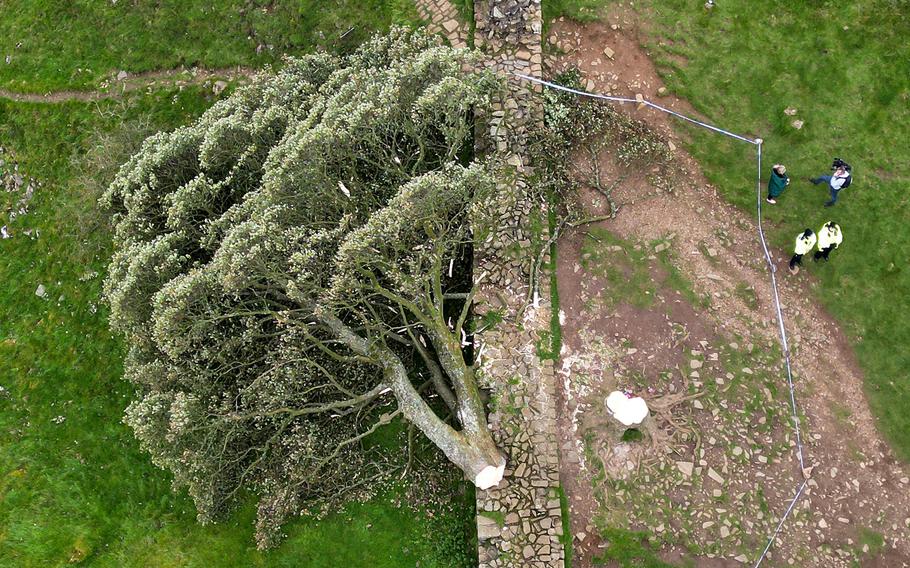The Sycamore Gap tree stood proudly in northeast England next to Hadrian’s Wall, an ancient boundary that once divided Roman Britannia and Caledonia. On the morning of Sept. 28, 2023, the tree was found in two pieces. It had been felled overnight in what the police believe was a deliberate act of vandalism. (Clementp.fr/Wikipedia)
On Thursday, the U.K. lost two national treasures. One was Michael Gambon, the actor who played Dumbledore in many of the Harry Potter movies, who died at 82 after a bout of pneumonia. The other was a tree.
The Sycamore Gap tree stood proudly in northeast England next to Hadrian’s Wall, an ancient boundary that once divided Roman Britannia and Caledonia. Framed beautifully by rising hillsides, the sycamore was likely one of the most photographed natural landmarks in the U.K., if not the world. It even had a starring role in the 1991 movie “Robin Hood: Prince of Thieves.” But on the morning of Sept. 28, the tree was found in two pieces. It had been felled overnight in what the police believe was a deliberate act of vandalism.
It has rightly been met with an outpouring of grief and anger. Two people have been arrested. There are two things we should take away from the tragedy, though. The first is a reminder of nature’s importance in our lives. The second is a call to action: Nature’s decline in the country goes far beyond Sycamore Gap.
Reading the messages of those mourning the tree, it’s clear just how much it means to people. Some proposed to their partners there. Others scattered the ashes of their loved ones nearby. For some, it was a place of healing after long illnesses and times of stress or simply the background for many happy memories with friends and family. This isn’t unique to Sycamore Gap or the U.K. Trees have given meaning to humanity for millennia, whether the holy banyans in India, Japan’s shinboku or the sacred groves found around the globe.

Aerial view of the ‘Sycamore Gap’ tree on Hadrian’s Wall lies on the ground, leaving behind only a stump in the spot it once proudly stood, on Sept. 28, 2023, northeast of Haltwhistle, England. (Jeff J Mitchell, Getty Images/TNS)
Immersion in nature has been proven time and again to benefit our mental and physical well-being. A study of 20,000 people by researchers at the University of Exeter found that people who spent two hours a week in green spaces were substantially more likely to report good health than those who didn’t. The psychological welfare of a population is linked to its proximity to nature and trees in both urban and rural settings. Research has linked experiences in nature with happiness, social cohesion, a sense of meaning, cognitive function, impulse inhibition and children’s school performance. So it’s no wonder we are drawn to places like Sycamore Gap.
Unfortunately, the same day of the massacre of the tree, a new report detailing the state of Britain’s natural landscapes was published. It should provoke the same emotional outpouring.
The study found that the U.K. is one of the most nature-depleted nations in the world. One in six species are at risk of extinction. Forty-three percent of British birds are threatened, with skylarks dropping 59% in abundance since monitoring began in 1970. Pollinating insects, such as bees, have decreased by 18% on average, while more than half of our flowering plants, mosses and relatives have disappeared from areas where they used to thrive. It’s a sobering assessment of a countryside struggling with the effects of intensive farming, unsustainable fishing practices and climate change. Indeed, it’s worth noting that the butchered sycamore tree, a non-native species, once stood among many others.
Unfortunately, such depletion is repeated across the world. The stock of natural capital per person declined by nearly 40% between 1992 and 2014, while produced capital per person doubled.
Now, I could talk about the importance of nature to economies and its place in the fight against the climate crisis. But, ultimately, people aren’t drawn to spend time or locate significant life events at Sycamore Gap or places like it because of its carbon sequestration properties or financial contribution to the U.K. They do so because nature is beautiful and makes us feel good. Let that be reason enough to preserve, protect and restore our wild spaces.
Lara Williams is a Bloomberg Opinion columnist covering climate change. This column does not necessarily reflect the opinion of the editorial board or Bloomberg LP and its owners.